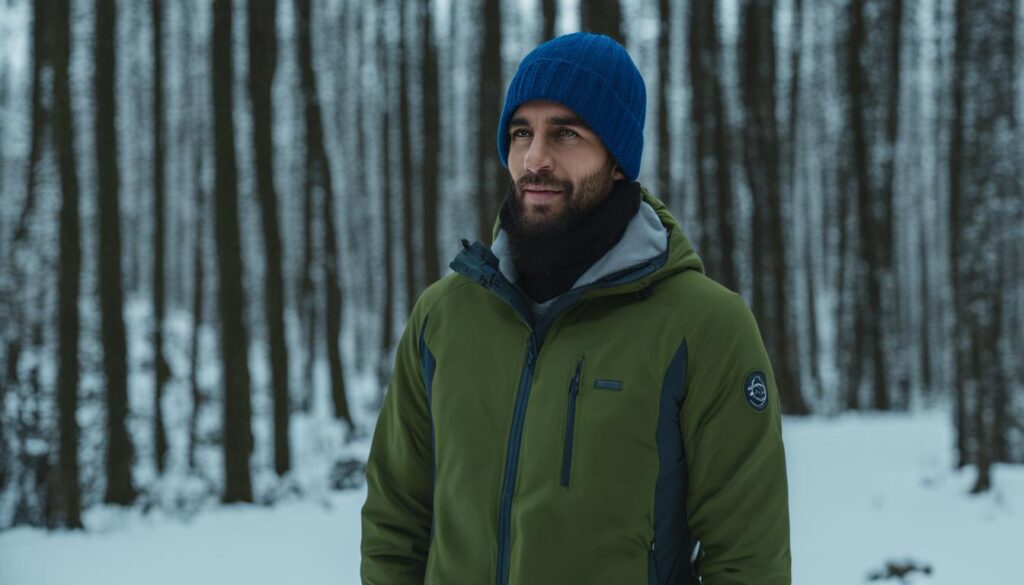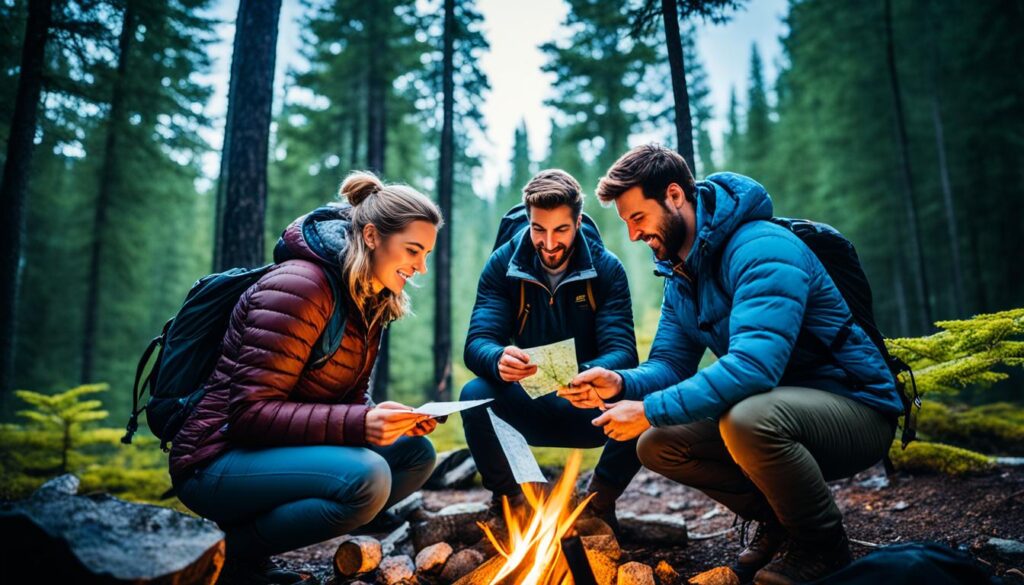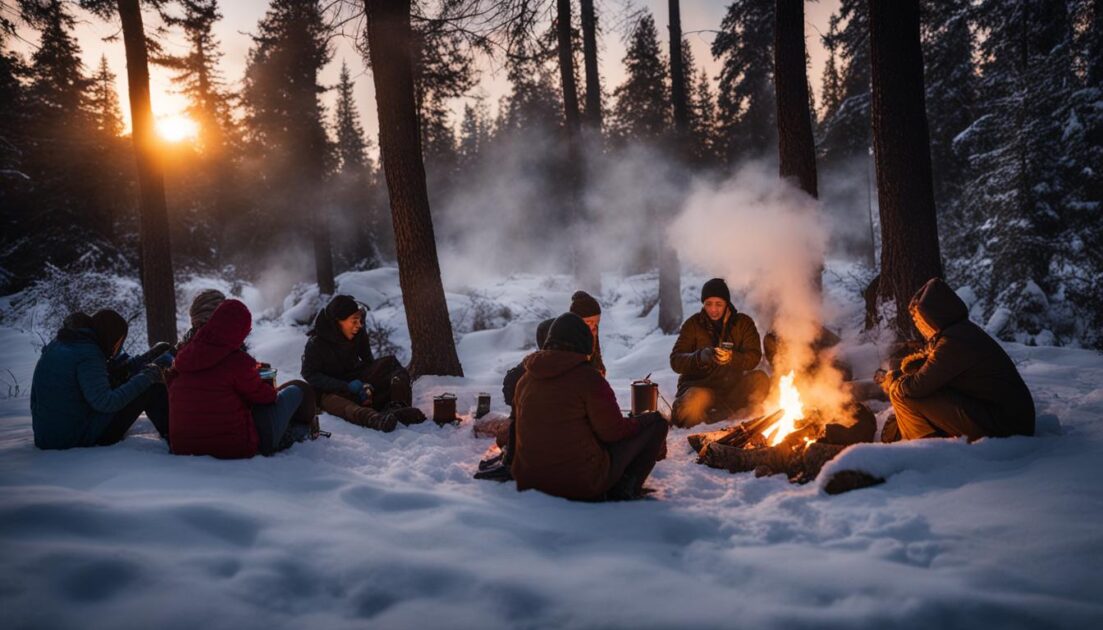Camping in cold weather can be an invigorating and memorable experience, but it’s crucial to know how to stay warm and comfortable during your outdoor adventure. The key to a cozy camping experience lies in understanding the art of staying warm when the temperatures drop. By following these expert tips and utilizing camping hacks for warmth, you can ensure that your camping trip is enjoyable, regardless of the weather conditions.
Key Takeaways:
- Layer your clothing to maximize warmth and comfort.
- Invest in the right camping gear for cold weather conditions.
- Choose a campsite that provides shelter from wind and exposure to morning sun.
- Keep your tent well-insulated to prevent condensation and maintain warmth.
- Optimize your sleeping setup for maximum coziness and insulation.
Layer Up for Maximum Warmth
One of the most effective ways to stay warm when camping in cold weather is by layering your clothing. Layering allows you to adjust your body temperature and stay comfortable throughout the day. It works by creating multiple air pockets that trap and retain warmth. Here’s how you can effectively layer your clothing for maximum warmth:
1. Start with a Moisture-Wicking Base Layer: A moisture-wicking base layer is crucial as it helps keep sweat away from your skin, preventing you from feeling damp and cold. Look for base layers made of synthetic materials or merino wool that can effectively wick away moisture.
2. Add Insulating Layers: Once you have your base layer, add insulating layers such as fleece or wool to provide warmth. These materials help trap heat and keep you cozy. Opt for lightweight and breathable options that allow for easy movement.
3. Finish with a Waterproof and Windproof Outer Layer: The outer layer acts as a shield against wind, rain, and snow. Look for a waterproof and windproof jacket or shell that can protect you from the elements. It’s important to choose a jacket that is breathable to prevent sweat buildup.
By layering your clothing, you can easily adjust your insulation levels based on the changing temperature and activity level. This allows you to stay warm and comfortable throughout the day, whether you’re hiking, setting up camp, or simply relaxing in your tent.
Layering Tips:
Here are some additional tips to make the most out of your layering system:
- Choose clothing items that can be easily layered and removed as needed.
- Avoid cotton as it retains moisture and can make you feel cold.
- Invest in quality outdoor clothing brands known for their warmth and durability.
- Consider wearing thermal leggings or long underwear beneath your pants for added insulation.
- Don’t forget to layer your feet! Wear moisture-wicking socks and consider adding insulating insoles to your boots.
Remember, layering is not just limited to your clothing. It can also be applied to your sleeping bag. Adding extra blankets or a sleeping bag liner can provide additional warmth during chilly nights.

With the right layering techniques, you can stay warm and comfortable in your tent, allowing you to fully enjoy your cold-weather camping adventure. So, don’t forget to pack your layers and be prepared for any temperature changes that come your way.
Choose the Right Camping Gear
Having the right camping gear is crucial for staying warm in cold weather. When preparing for winter camping, it’s essential to invest in gear that will provide insulation and protection from the elements. Here are some expert-recommended camping gear essentials for staying warm during cold nights:
1. Four-Season Tent
A four-season tent is specifically designed to withstand harsh weather conditions, making it ideal for winter camping. These tents are constructed with durable materials and come equipped with features like reinforced poles, snow skirts, and plenty of ventilation options. Make sure to choose a tent that provides insulation and protection from wind and snow.
2. Warm Sleeping Bag
A warm sleeping bag is a must-have for cold nights outdoors. Look for a sleeping bag that is rated for the expected temperatures. Sleeping bags with a lower temperature rating will offer better insulation and keep you cozy throughout the night. Additionally, consider using extra blankets or sleeping bag liners for added warmth.
3. Insulated Sleeping Pad
An insulated sleeping pad is essential for providing insulation from the cold ground. Choose a sleeping pad with a high R-value, which indicates its ability to resist heat transfer. This will help prevent the cold ground from sapping your body heat and keep you warm and comfortable throughout the night.
4. Camping Stove
A camping stove is an essential piece of gear for cooking warm and comforting meals during your winter camping trip. Look for a stove that can withstand low temperatures and has a reliable ignition system. Consider using a stove that utilizes liquid-fuel, as it performs better in cold conditions compared to canister stoves.
5. Headlamp
A reliable headlamp is essential for providing hands-free lighting during your camping adventure. Choose a headlamp with adjustable brightness levels and a long battery life. Opt for models that are specifically designed for cold weather and can withstand freezing temperatures.
6. Backpack
A sturdy backpack is essential for carrying all your gear during your winter camping trip. Look for a backpack with a spacious main compartment and multiple pockets for easy organization. Ensure that it is made of water-resistant materials to protect your belongings from snow or rain.

By choosing the right camping gear, you can ensure a comfortable and warm camping experience even in the coldest of nights. Remember to thoroughly research and invest in high-quality gear to guarantee your safety and enjoyment during your winter adventure.
Pick the Perfect Campsite
When it comes to camping in cold weather, selecting the right campsite can make all the difference in your comfort and warmth throughout your trip. Protecting yourself from wind and maximizing warmth should be your top priorities. Here are some key factors to consider when choosing a campsite:
1. Shelter from the Wind: Look for a campsite that offers natural wind protection. This can be in the form of a grove of trees or a terrain feature like a ridge. These natural barriers will help reduce the windchill and create a more comfortable camping environment.
2. Morning Sun: If possible, opt for a campsite that receives morning sun. The sun’s rays will help warm up your sleeping area, providing an extra source of heat. This can be especially beneficial during those chilly early morning hours.
3. Avoid Higher Elevations: Higher elevations tend to be colder due to thinner air and exposure to extreme weather conditions. Instead, choose lower elevations to camp where temperatures are generally milder.
By selecting a campsite that offers wind protection and access to morning sun while avoiding higher elevations, you can create a cozy and comfortable environment for your cold weather camping experience.
Expert Tip: Don’t forget to consider nearby water sources. While camping near a lake or river may provide scenic views, the proximity to water can make the campsite cooler and more susceptible to condensation.
Here’s an example of how to choose the perfect campsite:
| Campsite A | Campsite B | Campsite C |
|---|---|---|
| Sheltered from wind by trees | Exposed to strong winds | Some shelter from nearby hills |
| Receives morning sun | Limited sun exposure | Limited sun exposure |
| Lower elevation | Higher elevation | Lower elevation |
Based on the comparison above, Campsite A would be the ideal choice for warmth and protection against wind, while also benefiting from morning sun and a lower elevation.

Insulate Your Tent
When camping in winter, it’s crucial to insulate your tent properly to prevent condensation, maintain warmth, and have a comfortable night’s sleep. Here are some tent insulation tips to keep you cozy during those chilly nights.
Pitching your tent tightly
Pitching your tent tightly is essential to allow for good airflow. This helps prevent condensation buildup inside the tent, keeping it dry and insulated. Make sure all tent poles are secure and the rainfly is pulled taut.
Venting your tent
Creating proper ventilation is key to preventing condensation and maintaining a comfortable environment inside your tent. Leave a small opening at the top of your tent to allow moisture to escape. This promotes airflow and reduces the amount of condensation that forms on the walls and ceiling of the tent.
Consider a tent with fewer mesh panels and a full-coverage rainfly
Tents with fewer mesh panels and a full-coverage rainfly provide better insulation against the cold weather. Mesh panels allow more air circulation, which can lead to increased condensation. Opting for a tent with solid fabric walls and a rainfly that covers the entire tent helps retain heat and reduces condensation.
Insulate the tent floor
Insulating the floor of your tent is just as important as insulating the walls and ceiling. Use a groundsheet or an extra layer of foam padding underneath your sleeping area to provide an additional barrier between you and the cold ground. This extra insulation helps keep the tent floor warmer and more comfortable throughout the night.
By following these tent insulation tips, you can prevent condensation, maintain warmth, and make your winter camping experience enjoyable and cozy.
| Tent Insulation Tips |
|---|
| Pitch your tent tightly |
| Vent your tent |
| Consider a tent with fewer mesh panels and a full-coverage rainfly |
| Insulate the tent floor |
Warm Sleeping Essentials
A warm and cozy sleeping setup is essential for cold-weather camping. To ensure a comfortable night’s sleep, consider the following tips:
- Shake your sleeping bag: Before using your sleeping bag, give it a good shake to distribute the insulation and maximize its loft. This helps create more pockets of warm air, providing better insulation against the cold.
- Avoid tucking your head inside the sleeping bag: Though it may seem tempting to hide your head inside the sleeping bag for added warmth, this can lead to moisture buildup from breath condensation. Instead, use a warm hat to keep your head and neck protected.
- Consider using hand warmers: To add extra warmth to your sleeping bag, place hand warmers inside. These small, disposable packets provide long-lasting heat and can make a significant difference in keeping you cozy on chilly nights.
- Use a high-insulation sleeping pad: The cold ground can quickly sap away body heat, making it essential to insulate yourself from below. Invest in a high-insulation sleeping pad or use multiple pads to provide a barrier between you and the cold ground.
Additionally, don’t forget about your extremities. Your feet and hands are often the first to feel the cold, so be sure to wear warm socks and consider using warm gloves or mittens while sleeping.
Hydration and Other Tips
Staying hydrated while camping is essential, even in cold weather. Drinking plenty of water helps prevent dehydration, which can lead to hypothermia. Remember to always bring enough water with you and drink regularly throughout the day. A good rule of thumb is to consume at least 2 liters of water per day. Keep a reusable water bottle handy and refill it whenever necessary.
Another important tip for staying warm on a camping trip is to use lithium batteries for your camping gear. Unlike alkaline batteries, lithium batteries perform better in cold conditions, ensuring that your flashlights, headlamps, and other electronic devices stay powered up and functional.
When nature calls, don’t hold it in! Going to the bathroom actually helps keep your body warm. The process of holding urine requires your body to use extra energy to keep the bladder warm, which could be better used to keep you warm. So, if you need to go, find a designated bathroom area or dig a hole to relieve yourself. Just make sure to follow Leave No Trace principles and dispose of waste properly.
Lastly, when selecting a tent and sleeping bag for your winter camping trip, consider opting for smaller sizes. Smaller tents and snug-fitting sleeping bags trap warmth more effectively, helping you stay cozy throughout the night. Pay attention to the temperature ratings of your sleeping bag and choose appropriate layers and insulation based on the expected weather conditions. Being well-prepared with the right gear and following these essential tips will ensure that you have a warm, comfortable, and safe camping experience in winter.
FAQ
How can I stay warm when camping in cold weather?
Layer your clothing, invest in warm camping gear, choose a sheltered campsite, insulate your tent, and use warm sleeping essentials.
What clothing should I wear when camping in cold weather?
Start with a moisture-wicking base layer, add insulating layers such as fleece or wool, and finish with a waterproof and windproof outer layer.
What camping gear is essential for staying warm?
Invest in a four-season tent, a warm sleeping bag, an insulated sleeping pad, and other gear such as a camping stove and a headlamp.
How can I pick the right campsite for warmth?
Choose a campsite that is sheltered from the wind and located where it receives morning sun. Avoid higher elevations, as they tend to be colder.
How can I prevent condensation in my tent?
Pitch your tent tightly for good airflow, leave a small opening at the top for ventilation, consider using a tent with fewer mesh panels, and insulate the tent floor.
What sleeping essentials should I use to stay warm?
Shake your sleeping bag before use, avoid tucking your head inside the bag, consider using hand warmers, use a high-insulation sleeping pad, and wear warm socks and a hat.
How can I stay hydrated while camping in cold weather?
Drink plenty of water to prevent dehydration, use lithium batteries for camping gear, don’t hold it in when nature calls, and choose the right-sized tent and sleeping bag.
What are some other essential tips for staying warm on a camping trip?
Follow proper layering techniques, use camping hacks such as adding extra blankets or sleeping bag liners, and be mindful of staying comfortable and safe in cold temperatures.

